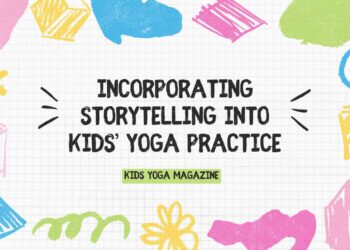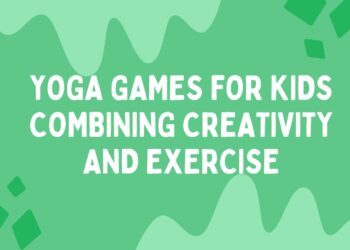Yoga is an excellent way for children to develop physical strength, flexibility, and mindfulness. However, keeping young minds engaged during a yoga session can sometimes be challenging. One effective way to make yoga more interactive and enjoyable for kids is by incorporating props into the practice. Using props not only makes yoga more fun but also helps children learn poses more easily, enhances their creativity, and supports their physical development. Here’s how you can use props to enhance kids’ yoga experience.
1. Why Use Props in Kids’ Yoga?
Props add an element of playfulness and creativity to yoga, making it more accessible and enjoyable for children. They serve various purposes:
- Engagement: Props capture children’s attention and keep them engaged throughout the session. Whether it’s a colorful scarf or a soft toy, props make the practice feel like a game, encouraging kids to participate more actively.
- Support and Alignment: Props can help children achieve correct alignment in poses, making it easier for them to learn and practice safely. For example, yoga blocks can be used to support the hands in poses where flexibility is still developing.
- Creativity and Imagination: Props inspire imaginative play, turning yoga into a creative adventure. A simple prop can become anything from a magic wand to a superhero’s shield, adding an element of storytelling and fun.
Benefit: Using props in kids’ yoga makes the practice more engaging, accessible, and imaginative, enhancing the overall experience.
2. Common Yoga Props and How to Use Them
Here are some common yoga props and creative ways to use them in a kids’ yoga session:
- Yoga Blocks: Yoga blocks are versatile tools that can be used for support in various poses.
- How to Use: In poses like Forward Fold or Triangle Pose, children can place their hands on a block if they can’t reach the floor comfortably. Blocks can also be used in balancing poses, like Half Moon Pose, to provide additional stability.
- Straps: Yoga straps help children achieve proper alignment in poses that require flexibility.
- How to Use: In Seated Forward Bend, children can loop the strap around their feet and gently pull themselves forward. This helps them maintain proper alignment without straining.
- Scarves or Ribbons: Lightweight scarves or ribbons add a sensory element to yoga practice.
- How to Use: Children can wave scarves as they move through flowing poses like Tree Pose or Dance Pose, enhancing their coordination and making the session more dynamic. Scarves can also be used in breathing exercises, where kids can watch the scarf float up as they inhale and fall as they exhale.
- Stuffed Animals: Soft toys can make yoga poses feel more comforting and approachable.
- How to Use: Ask children to balance a stuffed animal on their belly during Savasana to help them focus on deep breathing. In poses like Child’s Pose, kids can place the stuffed animal under their forehead for extra comfort.
- Yoga Mats with Designs: Mats with fun designs or colors can help guide children’s placement and alignment in poses.
- How to Use: Encourage kids to place their hands or feet on specific parts of the mat during poses, helping them learn proper positioning while making the practice more interactive.
Benefit: These props support children’s physical development, help them learn yoga poses more easily, and add a fun, sensory element to the practice.
3. Incorporating Props into Yoga Games
Props can be integrated into yoga games to make the practice more playful and engaging. Here are a few ideas:
- Yoga Obstacle Course: Set up an obstacle course using yoga props like blocks, straps, and scarves. Children can crawl under straps, balance on blocks, or wave scarves as they move from one pose to the next. This game promotes physical activity, coordination, and creative movement.
- Scarf Freeze Dance: Play music and have the children dance with scarves. When the music stops, they must freeze in a yoga pose, holding their scarf in a creative way. This game combines movement with mindfulness and encourages children to express themselves.
- Stuffed Animal Balance: Place a stuffed animal on different parts of the child’s body, like their head or back, and challenge them to move through poses without letting the animal fall. This game improves balance and focus while adding a playful element.
Benefit: Incorporating props into yoga games makes the practice more dynamic and fun, helping children develop coordination, balance, and focus in an enjoyable way.
4. Storytelling with Props
Props can be powerful tools in creating a narrative around the yoga practice, turning a simple session into an imaginative adventure.
- Adventure Themes: Use props to create a theme for the yoga session. For example, a scarf can become a superhero’s cape, and a block can be a stepping stone in a jungle adventure. As you guide children through the poses, integrate the props into the story, encouraging them to use their imagination.
- Interactive Storytelling: Allow children to choose props and contribute to the story. For instance, they might decide that the strap is a magic rope they need to climb, or the block is a treasure chest they need to open by performing a special yoga pose. This involvement makes the practice more personal and engaging.
Benefit: Storytelling with props enhances creativity, keeps children engaged, and makes the yoga practice more memorable and fun.
5. Tips for Using Props Effectively
To ensure that props enhance rather than distract from the yoga practice, consider these tips:
- Safety First: Ensure that all props are safe and appropriate for the child’s age and physical abilities. Avoid small items that could be choking hazards for younger children.
- Keep It Simple: Don’t overwhelm the session with too many props. Select a few key items that fit the theme or goal of the practice.
- Encourage Exploration: Allow children to explore the props and use them in their own creative ways. This exploration can lead to new and inventive uses for familiar items.
- Balance Play with Practice: While props add fun, remember to balance playfulness with the core principles of yoga—mindfulness, breath, and movement. Use props to enhance these elements, not distract from them.
Benefit: By using props effectively, you can create a balanced, engaging, and enriching yoga experience that supports both physical and creative development.
Conclusion
Incorporating props into kids’ yoga practice is a fantastic way to enhance their experience, making yoga more engaging, creative, and supportive. Props not only help children learn and perfect poses but also add an element of play that keeps them motivated and excited about the practice. Whether you’re using blocks for alignment, scarves for creative movement, or stuffed animals for comfort, these tools can transform a simple yoga session into a dynamic and enjoyable adventure. By thoughtfully integrating props into the practice, you can foster a love for yoga that will benefit children physically, mentally, and emotionally.











